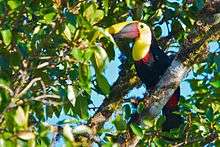Yellow-throated toucan
| Yellow-throated toucan | |
|---|---|
 | |
| Scientific classification | |
| Kingdom: | Animalia |
| Phylum: | Chordata |
| Class: | Aves |
| Order: | Piciformes |
| Family: | Ramphastidae |
| Genus: | Ramphastos |
| Species: | R. ambiguus |
| Binomial name | |
| Ramphastos ambiguus Swainson, 1823 | |
| Subspecies | |
|
See text | |
| Synonyms | |
| |
The yellow-throated toucan (Ramphastos ambiguus) is a large toucan from northern South America.
Taxonomy
The yellow-throated toucan was at one time considered to be closely related to the Choco toucan but it is only distantly related per genetics. However, it is very closely related to the chestnut-mandibled toucan and the two species are now considered conspecific by the IOC. They do not overlap in the wild and are found to differ 1.35% in mitochondrial DNA. Some other authourities continue to classify the yellow-throated and chestnut-mandibled toucans as separate species.[2]
Subspecies
Three subspecies are recognized:[3]
- Chestnut-mandibled toucan (R. a. swainsonii) - (Gould, 1833): Found in south-eastern Honduras to western Ecuador
- R. a. ambiguus - Swainson, 1823: Found in south-western Colombia to south-central Peru
- R. a. abbreviatus - Cabanis, 1862: Found in north-eastern Colombia and northern Venezuela
Description

This species has a total length of 47–61 cm (19–24 in) and weighs from 584 to 746 g (1.287 to 1.645 lb).[4] Among all toucans and living members of the Piciformes order, only the toco toucan and the white-throated toucan average larger than the similarly-sized black-mandibled and chestnut-mandibled races. Among standard measurements, the short wing chord is 20.4 to 24.8 cm (8.0 to 9.8 in), the huge bill is 12.9 to 20 cm (5.1 to 7.9 in), the tail is 14.8 to 17.5 cm (5.8 to 6.9 in), and the tarsus is 4.7 to 5.9 cm (1.9 to 2.3 in).[5]
Its plumage is mainly black. Upper breast and throat are bright yellow, with a thin red border on the throat, a creamy rump and a scarlet anal area. The bill is bicolor and massive, a little shorter in the female. It is lemon-yellowish on the upper side and blackish on the rest of the maxilla and on the mandible, often brown close to the base. The skin of the face around the eyes is pale green or yellow-green.[6]
Distribution and habitat
The yellow-throated toucan ranges along the eastern slope of the Andes from Peru, north through Ecuador and Colombia, to Venezuela as far as the coastal ranges.
This species is adapted to a wide variety of habitats, from plains to tropical and subtropical forests. It lives at altitudes of 100–2400 m. in humid montane forests, with a preference for the canopy and edge.
Behaviour and ecology
The call of the yellow-throated toucan is a yelping, far-carrying cry described as “Díos te dé” (Spanish for "God give you..."). This species feeds mainly on fruits, but occasionally on lizards, rodents, smaller birds and insects.
The breeding season lasts from March to June. The nests are usually located in a cavity in rotting wood at 10–25 meters above the ground. The females lay 2-4 white eggs incubating for about two weeks.[6]
References
- ↑ BirdLife International (2015). "Ramphastos ambiguus". IUCN Red List of Threatened Species. Version 2015.4. International Union for Conservation of Nature. Retrieved 30 November 2015.
- ↑ "Ramphastos swainsonii - Avibase". avibase.bsc-eoc.org. Retrieved 2016-11-08.
- ↑ "IOC World Bird List 6.4". IOC World Bird List Datasets. doi:10.14344/ioc.ml.6.4.
- ↑ Nashville Zoo
- ↑ Toucans, Barbets and Honeyguides (Bird Families of the World) by Lester Short & Jennifer Horne. Oxford University Press (2001), ISBN 978-0198546665.
- 1 2 Oiseaux.net
External links
- Bibliography of online, ornithological articles which explore the natural history of the black-mandibled toucan, Ramphastos ambiguus ambiguus.
- "Ramphastos ambiguus" videos on the Internet Bird Collection
- Neotrppican Birds
- "Ramphastos ambiguus". National Center for Biotechnology Information (NCBI).
